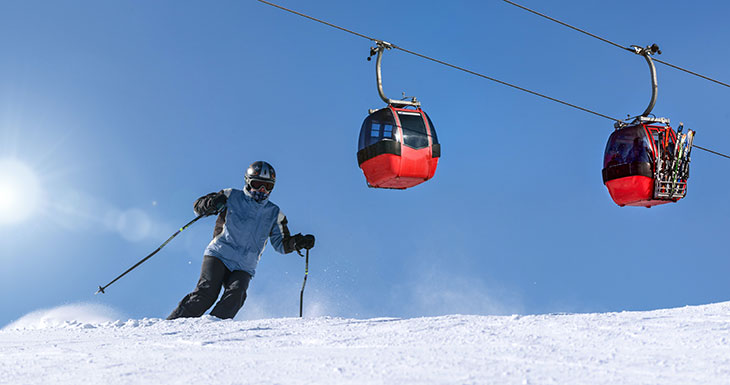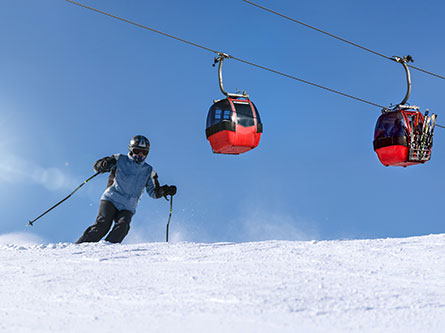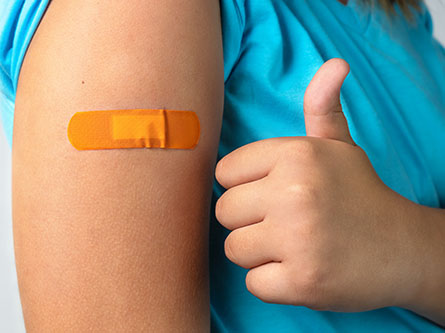
It's that time of year again: There's fresh powder in the mountains, and many of us are eager to hit the slopes. However, along with the fun of skiing or snowboarding comes the risk of injury.
On average, between two and four skiers per 1,000 are injured each day on the slopes in the U.S., according to the UC Davis Health Sports Medicine team. Injury rates are similar for snowboarding.
For skiers, the good news is that improvements in technology have slightly reduced injury rates. Shaped skis have allowed people to learn faster and stay in better control.
Boot-top leg fractures (facture of your tibia or fibula) are less common. But knee sprains, shoulder injuries, and thumb sprains (such as skier’s thumb) still occur.
For snowboarders, injuries to the wrist, shoulder, and head are most common. Snowboarders tend to reach out their hands more during a fall, since both feet are locked onto the board.
To help keep you safe on the slopes, here are some tips to avoid injury:
- Overall fitness and regular cardio exercises can help you prevent injury. Staying in shape is important. We have a list of exercises below to help strengthen your lower body and core.
- Warm up your muscles before you head down the mountain. Cold muscles are at a greater risk for injury. Gently stretch your hamstrings, quadriceps (thigh muscles), hips, and calf muscles before and after skiing or snowboarding.
- Wear a helmet. If you fall, a properly fitted helmet can reduce the risk of ski and snowboard head injuries. Helmets can also provide protection in the event of a collision with someone who has lost control.
- Staying hydrated is also important before, during, and after skiing or snowboarding.
- When renting or buying ski or snowboard equipment, don't overstate your skill level. Make sure you get equipment that will be safe for you and your ability.
- Use ski poles without straps. That will allow you to release the pole during a mishap and prevents snags that cause injuries to your thumbs and arms.
- Rest when you're tired. Most injuries happen after lunchtime when fatigue sets in.
- Wear layered clothing to keep your body warm, along with sunglasses and/or goggles to protect your eyes. While UV rays from the sun may not be as strong during the winter, sunscreen is still important because the reflection off the snow amplifies the effects of UV rays. You're also at higher elevation, making the sun's effects stronger.
- Snowboarders should consider wearing wrist guards to protect them when falling.
5 exercises to help prevent ski and snowboard injuries
There are some exercises you can do at home to keep your body in shape for winter fun. Here are some recommendations from our sports medicine team to help you avoid injuries to your lower body:
1. Plank
Start by lying on your stomach and rise onto your toes and elbows with your forearms on the ground. Keep your elbows lined up vertically with your shoulders. Tighten your glutes and make sure your belly doesn't sag, but also make sure your buttocks aren't lifted in the air.
Engage your whole core. Your body should look like it's one straight line from your legs to your head. Switch over to a slide plank to strengthen your oblique muscles of your core.
2. Superman stability ball
On a stability ball, lie on your stomach with your toes touching the ground. Raise your upper body and put your arms straight out in front of your head. Position your entire body so it's in a straight line.
This exercise strengthens your entire posterior chain, or all the muscles on the backside of your body. This includes your back muscles, glutes, hamstrings, and core. Strengthening these muscles is important because they help you stay upright as you go down the slopes.
3. Stability ball bridge/curl
Lie on your back with the back of your ankle area on a stability ball. Apply pressure to the ball while lifting your hips, keeping your shoulders, neck, and head on the ground. You can lift and hold, which focuses on strengthening your buttocks and core. Or you can do a curl by bringing the ball back towards you while bending your knees and lifting your buttocks, which focuses more on the hamstring. The key is to keep your hip bones as straight as possible without rotating.
You will feel your glutes and hamstring activate. Exercises like this can help prevent injuries to your knees, especially the ACL.
4. Squat
There are two versions to help with strength. The first is a chair squat. Sit into your back pocket and onto the chair. Stick your buttocks out first before bending your legs. Be sure to keep looking forward with your chest up, and don't let your knees bend forward past your toes. The key with this is you want to tighten your core, engage your glutes, and engage your quadriceps muscles.
If you want to do something more advanced, you can try a goblet squat with a weight. The key with this is to keep looking forward and not up. When you look up, you will load up your back muscles, which takes the focus off your legs.
Squats are important because that's what you're doing most of the time when you're sliding down the mountain.
5. Lateral band walk
Put an exercise band on the outer sides of both feet along the balls of your feet. Step side to side in a little bit of a squat to activate your core, glutes, and quads. As you step side to side, you're really focusing on the gluteus medius, an important muscle along your hip.
This exercise for hip stability is key for knee injury prevention because knee stability depends on how strong your hips are.
Sports performance and injury prevention at UC Davis Health
Our sports medicine team can help you meet your personal performance and fitness goals while helping you avoid injury. Here are a few resources you may find useful:
- Sports performance: Our Sports Performance Program offers a variety of assessments to help you get the most out of your workout and fitness training.
- Sports injury prevention: Our team can analyze and uncover risk factors that may predispose you to injury.
- Overuse injury prevention in youth sports: Overuse injuries are responsible for nearly half of all sports injuries in teens. Learn the warning signs and recommendations for prevention.
- Body composition analysis: Our services look at your percentage of fat, bone and muscle to help guide your training and nutritional approach.





